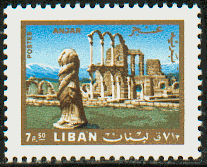

The city of Anjar was founded by Caliph Walid I at the beginning of the 8th century.
Known in ancient times as Heliopolis, greek for "city of the sun", the modern name may be connected with the ancient Canaanite god Baal. The ruins of the ancient town are centered around the acropolis which incorporates the Temple of Jupiter (which took 200 years to complete) and the Temple of Bacchus, which was erected around 150 AD. Both temples were dedicated to the Heliopolitan triad - Hadal, the Syrian God of Thunder, Atorgatis, the Syrian Goddess of Nature, and a youthful god who was a protector of crops. These ruins are an important relic of the so called pagan cults of the time.
Byblos is said to be the oldest inhabited city in the world, the source of the first Phoenician letters that gave us our alphabet. Byblos was the major seaport of the east Mediterranean during the 3rd millenium BC. The ruins include the perimeter walls, the Temple of Baalat-Gebal (the goddess of the city), the Temple of the Gbelisks and the royal tombs. There are also ruins dating from Roman times and the crusader castle and church.

The best-known cedar is the cedar of Lebanon, mentioned often in the Old Testament; the First Temple of Solomon was built of this wood.
Designed in 1962 by Brazillian architect Oscar Niemeyer.
Lynn Salmon <>{
Last Updated: September 17, 2023